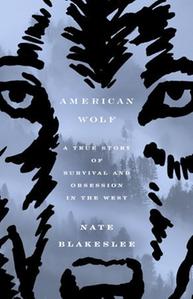
|
|
| photo: Jeff Wilson | |
After writing award-winning articles for Texas Monthly and the Texas Observer, Nate Blakeslee spent a few years investigating the Yellowstone National Park wolves, reintroduced in 1995 after an absence of 75 years. Focusing on the charismatic alpha female pack leader O-Six, American Wolf (reviewed below) covers the habits and habitat of the park wolves, the people studying them, and the political friction between the area's conservationists, ranchers and outfitters.
You came across O-Six when you joined a wolf-watching expedition at Yellowstone. Was it difficult switching gears from your Texas-centric stories to a wildlife story?
I met Rick McIntyre, one of the main characters in the book, in 2007, when he gave a presentation to a weeklong wolf-watching class I attended in Yellowstone. I had written several stories about the politics of wildlife management in Texas, but wolves were new to me. Rick's legendary dedication--he came to the park before dawn seven days a week without fail for years, spending hours watching wolves and documenting their behavior--had already made him a local celebrity. I thought at the time that he would make a great subject for a magazine profile, but I wasn't sure if telling his story was the right way to write about the political struggle over wolves in the West. When I heard that the park's most famous wolf, O-Six, had died in the first legal wolf-hunting season in Wyoming in generations, I realized that her life--seen through Rick's eyes--was the way into the story, and that the material was far too rich for a single magazine piece.
McIntyre--a reclusive National Park Service naturalist--strikes me as the most interesting character in the book. Was it difficult to get him to open up?
I found Rick to be the most intriguing character, too, at least among the humans in the book. He has spent most of his career talking to strangers about wildlife, yet he is a shy, private man, who--all things considered--prefers the company of wolves to people. He wasn't averse to the idea of being profiled in the book, but it was a challenge to get him to share his innermost feelings about the most tragic elements of his experience, especially the death of wolves he had followed for years. Like everyone who works for the Park Service, Rick is very cognizant of the complex politics of wolf management, and hesitant to criticize policies--like wolf hunting--instituted by state authorities in the areas surrounding the park, or those of the U.S. Fish and Wildlife Service, which made the controversial decision to remove wolves from the endangered species list in the Northern Rockies.
Wyoming outfitter and lifelong hunter Steven Turnbull is also quite a character, with his self-described "downwardly mobile" life. Since he probably figured you for a wolf-hugger, how did you get him to open up?
As the man who shot arguably the world's most famous wild animal, there is no question that Turnbull took a risk when he agreed to talk to me. He asked for no special consideration; only that he be allowed to remain anonymous. To that end (as I explain in a note to readers in the front of the book), I changed not only his name, but some identifying characteristics as well, while leaving in enough of his actual circumstances that readers will get a good feel for him as a character, his personality and motivations. He knows he will be the "bad guy" in the story for most readers. He cooperated because he wanted his point of view to be represented in the book, and I very much did as well.  The one-page O-Six lineage chart you include is helpful. Did you set up some sort of matrix and/or map of all the Yellowstone wolves in order to understand how the ecosystem evolved?
The one-page O-Six lineage chart you include is helpful. Did you set up some sort of matrix and/or map of all the Yellowstone wolves in order to understand how the ecosystem evolved?
Dedicated wolf watchers like Rick McIntyre can recite the lineage of every pack in the park, going back to 1995, when wolves were first reintroduced to Yellowstone. (They had been hunted out by the 1920s.) The history can get pretty byzantine. Pack leadership changes frequently--often as a result of violent conflict with neighboring clans--and there is a constant flow of young wolves leaving their natal packs to join others, or to start new families of their own. But this is one of the reasons wolves are so compelling: their intricate social lives and tribal ways set them apart from other animals, and make their stories feel familiar to us.
Rumor on the Internet is that Leonardo DiCaprio has movie rights. How do you feel about that?
Leonardo DiCaprio's production company has optioned the book and a screenplay is in the works. If it comes to fruition, I'm hopeful we'll see an accurate depiction of wolves and their behavior. So often we don't; more than one recent film has shown wolves chasing and attacking humans, for example, which in reality is an extremely rare occurrence. There hasn't been a single such incident in the Northern Rockies in the two decades since reintroduction, and there are very few recorded attacks in American history, even though wolves were found virtually everywhere on this continent when Europeans first arrived.
For centuries, wolves were a symbol of evil in Western culture, which is a legacy of our pastoral roots. Any creature that preyed on livestock was considered a threat, but wolves--as the most widely distributed land mammal on the planet--posed the biggest obstacle by far for shepherds and the communities that relied on them. It is no exaggeration to say that almost every expansion of human civilization in the northern hemisphere since humans left Africa came at the expense of wolves. It was a dynamic that held until very recently, when wolves began to make a comeback, aided by programs like the Yellowstone reintroduction. Yet they still inspire fear and resentment in some circles, which, in my view, puts the onus on anyone depicting wolves in popular culture to be as responsible and accurate as possible. --Bruce Jacobs, founding partner, Watermark Books & Cafe, Wichita, Kan.

